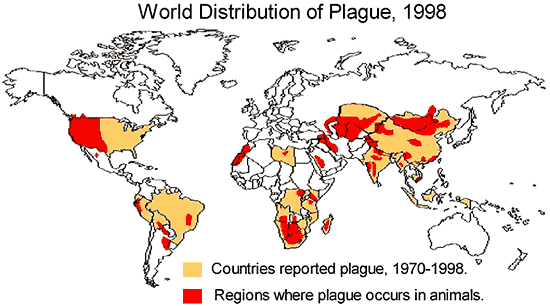Plague
Plague is an infectious disease of animals and humans caused by a bacterium named Yersinia pestis. People usually get plague from being bitten by a rodent flea that is carrying the plague bacterium or by handling an infected animal. Millions of people in Europe died from plague in the Middle Ages, when human homes and places of work were inhabited by flea-infested rats. Today, modern antibiotics are effective against plague, but if an infected person is not treated promptly, the disease is likely to cause illness or death.
Wild rodents in certain areas around the world are infected with plague. Outbreaks in people still occur in rural communities or in cities. They are usually associated with infected rats and rat fleas that live in the home. In the United States, the last urban plague epidemic occurred in Los Angeles in 1924-25. Since then, human plague in the United States has occurred as mostly scattered cases in rural areas (an average of 10 to 15 persons each year). Globally, the World Health Organization reports 1,000 to 3,000 cases of plague every year. In North America, plague is found in certain animals and their fleas from the Pacific Coast to the Great Plains, and from southwestern Canada to Mexico. Most human cases in the United States occur in two regions: 1) northern New Mexico, northern Arizona, and southern Colorado; and 2) California, southern Oregon, and far western Nevada. Plague also exists in Africa, Asia, and South America (see map).

